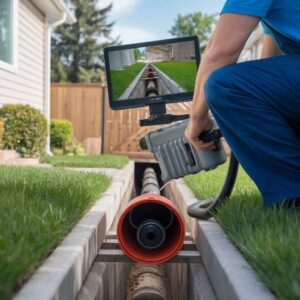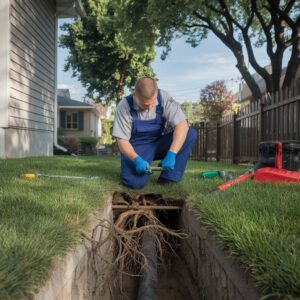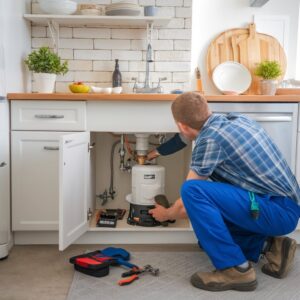Trenchless sewer repair offers a high-efficiency solution to fix sewer lines without disrupting large-scale excavation. This technology uses techniques like pipe bursting and pipe lining to enhance the durability and structural integrity of sewer systems. It minimizes environmental disruption, reduces repair time, and preserves property aesthetics, making it a cost-effective alternative to traditional methods. Trenchless repair suits various pipe materials and issues, offering a versatile solution for sewer challenges. Learn more about its benefits and applications.
Key Takeaways
- Trenchless sewer repair minimizes excavation, preserving landscapes and structures during pipe rehabilitation.
- Techniques include pipe bursting and pipe lining, enhancing repair efficiency and pipe longevity.
- It reduces environmental disruption and repair costs compared to traditional methods.
- Repairs are completed quickly, minimizing inconvenience for property owners.
- Advanced camera inspections accurately locate problems for efficient trenchless intervention.
How Trenchless Sewer Repair Works: An Overview
Trenchless sewer repair is a minimally invasive method that rehabilitates existing sewer pipelines without requiring extensive excavation. Sewer inspection is often the first step to evaluate the condition of the pipes and identify the damage before deciding on the best repair method.
Pipe lining involves placing a resin-coated, flexible tube into the damaged pipe, which is then expanded and hardened to create a strong, long-lasting new lining within the existing pipe.
This technology reduces disruption to surrounding environments and enhances the efficiency and longevity of sewer pipe repair by providing a seamless solution that effectively restores structural integrity.
What Is the Trenchless Sewer Repair Process Using Pipe Lining?
Trenchless sewer repair using pipe lining, also known as cured-in-place pipe (CIPP) technology, offers a minimally invasive solution for refurbishing damaged sewer lines.
This repair begins with a thorough inspection of the existing sewer line to assess the extent of the damage. A flexible liner saturated with resin is inserted into the pipe system using trenchless methods, conforming to the interior contours.
The resin is then cured, forming a new, durable pipe within the old structure, effectively sealing cracks and leaks. This sewer repair technology minimizes disruption to surrounding areas, as no extensive digging is required.
As a result, pipe lining provides a cost-effective and efficient approach to sewer line repair, extending the lifespan of the infrastructure.
How Does Trenchless Technology Make Sewer Pipe Repairs More Efficient?
Building upon the understanding of trenchless sewer repair using pipe lining, this technology considerably enhances the efficiency and effectiveness of sewer pipe repair. Trenchless pipe repair eliminates the need for extensive excavation, reducing disruption and costs. Dryable pipes are addressed with minimal surface disruption by employing pipe bursting and lining. This sewer repair technology allows a new pipe lining to be inserted directly into the existing sewer line, forming a durable interior layer. The following table highlights key comparisons:
| Aspect | Traditional Repair |
|---|---|
| Surface Disruption | High |
| Repair Methods | Open Trench Excavation |
| Installation Time | Lengthy |
| Durability | Moderate |
| Cost Efficiency | Low |
Trenchless methods revolutionize sewer line maintenance, making them a preferred choice in modern infrastructure.

Why Choose Trenchless Pipe Repair Over Traditional Sewer Repair?
Trenchless pipe repair provides multiple benefits compared to conventional excavation techniques, including reduced environmental disruption, lower overall costs, and increased efficiency.
By eliminating the need for extensive digging, trenchless techniques markedly decrease the time required for repair works, minimizing inconvenience for property owners and municipalities.
However, while trenchless methods excel in many scenarios, evaluating specific conditions and constraints is essential to determine the most suitable approach for each unique repair situation.
Why Trenchless Sewer Repair Is Better Than Conventional Excavation Methods
Trenchless methods offer significant advantages in pipe repair by minimizing surface disruption. Unlike excavation repair, which involves extensive digging and landscape alteration, trenchless technology performs sewer line repair and pipe replacement with minimal ground disturbance.
This is a key benefit of trenchless sewer repair, as it preserves existing structures and landscapes, reducing restoration costs associated with traditional sewer repair.
Additionally, trenchless methods enhance operational efficiency by employing modern methods like pipe bursting and cured-in-place pipe (CIPP) lining.
As a result, trenchless sewer repair methods provide a cost-effective, environmentally friendly alternative to conventional excavation repair, highlighting the benefits of trenchless technology in modern infrastructure maintenance.
How Does Trenchless Sewer Line Repair Work to Solve Common Pipe Issues?
Trenchless sewer line repair effectively addresses common pipe issues such as clogs and structural damage by employing pipe bursting and pipe lining techniques.
Pipe bursting involves fragmenting the old pipe while simultaneously installing a new one, whereas pipe lining creates a new inner pipe using a resin-coated liner. Both methods ensure minimal disruption to the surrounding environment.
For homeowners and businesses, recognizing the signs of sewer problems and contacting a plumbing repair service promptly can optimize the benefits of trenchless technology.
Can Trenchless Repair Handle a Clog in the Sewer System?
Effectively addressing a clog in the sewer system is a challenge that trenchless sewer repair techniques can adeptly tackle.
Trenchless repair involves minimal excavation, efficiently resolving sewer line issues. Here’s how it works:
- Camera Inspection: A detailed camera inspection is conducted to locate and assess the sewer system’s clog accurately.
- Pipe Liner Installation: A pipe liner is introduced into the existing pipe, creating a seamless interior and preventing further obstructions.
- Trenchless Methods Like Pipe Bursting: Though not elaborated here, these methods are integral to the repair service.
- Repair Service Execution: Utilizing trenchless sewer line repair, professionals employ specialized tools to clear the clog, restoring ideal flow without extensive digging.
This method of sewer maintenance guarantees efficient and effective solutions.
How Does Pipe Bursting and Pipe Lining Help in Sewer Pipe Repair?
Two innovative techniques stand out when addressing the persistent challenges of sewer pipe repair: pipe bursting and pipe lining. Trenchless sewer repair utilizes these methods to resolve sewer issues without extensive excavation efficiently. Pipe bursting involves breaking the existing damaged sewer pipe while simultaneously pulling a new pipe into its place. This method guarantees a seamless repair and replacement process. Conversely, pipe lining, often called cured-in-place pipe (CIPP), inserts a resin-coated liner into the damaged sewer, creating a new pipe within the old one.
| Technique | Process Description | Benefits |
|---|---|---|
| Pipe Bursting | Breaks old pipe, installs new pipe | Minimal excavation |
| Pipe Lining | Installs a liner inside the damaged pipe | Structural integrity |
| Trenchless | No open trenches required | Efficient repair |
When Should You Call a Plumber for Trenchless Pipe Repair?
For homeowners and property managers, determining the right moment to enlist a plumbing repair service for trenchless pipe repair can prevent further damage and minimize costs.
When repair needs arise, recognizing signs can streamline access and repair of existing sewer systems. Typical scenarios include:
- Old Sewer Line Issues: Trenchless sewer repair methods are efficient when deterioration in an old sewer line is suspected.
- Frequent Backups or Clogs: Persistent plumbing issues may warrant a thorough sewer repair.
- Signs of Ground Shifting: If soil movement is noted, replacing underground sewer components with trenchless pipe techniques may be necessary.
- Minimal Disruption Requirement: When minimal landscape disturbance is prioritized, trenchless options provide a viable repair alternative.
Evaluating these conditions guarantees timely intervention.

What Are the Different Trenchless Sewer Repair Methods?
Repairing a sewer line using modern methods can be less disruptive than traditional excavation. One approach, trenchless sewer repair, includes techniques like pipe bursting and cured-in-place pipe (CIPP) lining.
These solutions minimize the need for major digging while protecting existing landscapes and structures. If you look at how trenchless sewer methods work, you’ll see they enhance the durability and longevity of sewer systems. Learn what trenchless sewer repair involves to understand why it’s often preferred for efficient, long-lasting fixes.
How Does Trenchless Pipe Repair Work Without Major Excavation?
Remarkably, advancing trenchless pipe repair technologies has revolutionized sewer maintenance by eliminating the need for extensive digging.
Trenchless sewer repair employs innovative methods, allowing for pipe repair and replacement without major excavation.
- Slip Lining: A smaller diameter pipe is inserted into the existing pipeline for reinforcement.
- Directional Drilling: Utilizes advanced technology to create new pipe paths under obstacles without surface disruption.
These trenchless methods enhance efficiency and minimize surface impact.
How Does Trenchless Sewer Pipe Repair Protect Your Property?
During the sewer repair, trenchless technology offers significant protection to property by minimizing disruption to landscapes, driveways, and structures.
Trenchless sewer repair involves pipe lining and pipe bursting, eliminating the need for extensive digging. In pipe lining, a resin-coated liner is inserted into the existing pipe, creating a seamless, durable inner layer.
Pipe bursting involves breaking the old pipe while pulling a new one into place. These techniques guarantee that repairs and replacements are completed efficiently, reducing the impact on the surrounding environment.
Trenchless pipe rehabilitation and repair works by feeding a new pipe through minor access points, preserving the aesthetic and structural integrity of the property, and guaranteeing that repairs take less time.
Is Trenchless Sewer Repair Right for Your Home?
Trenchless sewer repair offers homeowners significant advantages, including minimal landscaping disruption and reduced project time.
Professionals in the field explain the repair process as a non-invasive alternative to traditional methods, employing modern technologies like pipe bursting and cured-in-place pipe (CIPP) lining.
Selecting a repair service with expertise in trenchless techniques is vital to guarantee the project is executed efficiently and effectively, providing long-term durability and reliability.
What Are the Benefits of Trenchless Sewer for Homeowners?
Trenchless sewer repair provides several key benefits when addressing house sewer pipe problems.
- Minimal Disruption: Unlike traditional methods, trenchless techniques avoid extensive digging, preserve landscaping, and reduce the impact on daily life.
- Cost-Effectiveness: Although initial costs may seem higher, avoiding extensive excavation can make it worth the investment, especially for an old house sewer.
- Durability and Longevity: Trenchless methods are used to repair or replace and enhance the lifespan of plumbing systems, ensuring fewer future repairs.
- Versatility: These techniques are adaptable and suitable for various pipe materials. Repair offers flexibility in addressing diverse issues, effectively showcasing the pros and cons of trenchless methods.
What to Consider When Selecting a Trenchless Sewer Line Repair Service
Choosing a company specializing in trenchless sewer repair guarantees efficient and precise pipe repair, which can save sewer pipes from complete replacement when they are not beyond repair.
The exemplary service will determine the most suitable method for your situation.
Here is a guide to selecting a competent repair service:
- Expertise: Verify that the service specializes in trenchless technology.
- Experience: Look for a proven track record in handling diverse sewer line issues.
- Techniques: Confirm they are familiar with multiple trenchless methods.
- Assessment: They should thoroughly evaluate your sewer line to confirm trenchless repair as the most suitable option.
This guarantees a more efficient and effective repair process.

Conclusion
To conclude, trenchless sewer repair offers a highly efficient and less invasive alternative to traditional methods. Advanced techniques such as pipe bursting and cured-in-place pipe lining address common pipe issues with minimal disruption. These methods save time, reduce costs, and preserve landscaping and infrastructure. Homeowners should consider factors such as pipe condition, location, and budget when determining if trenchless repair is the best solution.







